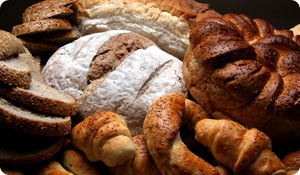
Having a wheat allergy can place many limits on what you can safely eat. However, it doesn't mean you have to give up all your favorite foods. It's simple to cook delicious treats at home, using allergy-free ingredients in exchange for wheat.
Since most recipes call for wheat flour, you'll need to find wheat substitutes that are safe to eat. Just keep in mind that each one will have a slightly different texture and flavor, so you'll want to find something that works with your personal preferences and tastes.
Wheat Substitute Options
You'll most likely be able to find a variety of wheat-free flours in your area supermarket or health food store. As a general rule, wheat-free flour will stand in place of one cup of wheat flour. If your recipe calls for less or more, do the math to adjust the amount accordingly. Here are some great wheat-free flour choices:
- Chick Pea Flour (or Garbanzo Bean) (7/8 cup): This is made from beans that have been ground down. It adds a nutty flavor to recipes.
- Potato Starch Flour (3/4 cup): This flour is made from potatoes. It won't add a potato flavor once it's cooked, though, so it can be very versatile. This type of flour is usually a good choice for a wide variety of recipes.
- Rice Flour (7/8 cup): Rice flour is a common wheat substitute and comes in three options: white, brown, and sweet. White rice flour comes from rice kernels and works well with many foods. Brown rice flour is heartier than the white variety and also more nutritious. It's a good choice for breads and other baked goods. Sweet rice flour can be used for desserts and breaded dishes and can also help thicken sauces.
- Rolled Oats (1-1/3 cups): Because rolled oats can be ground into flour, they're a good option for many baked goods and dishes. Oats offer a good supply of protein and soluble fiber, making them very nutritious.
- Tapioca Flour (1 cup): Tapioca flour comes from the cassava root and has a chewy texture, making it ideal for certain types of breads.
(Note that some people prefer to make a mixture of several of these ingredients in order to get the consistency and flavor they desire.)
When you cook with wheat-free flours, keep these few tips in mind. First, a baked good with wheat substitute usually won't rise as well as one made with wheat flour. To get around this, some chefs recommend lowering your cooking temperature 25 degrees and letting your recipe bake a little longer. Second, make smaller portions for better results, such as cookies, cupcakes, and individual servings, rather than cakes and breads that have a larger surface and may be more compromised if the consistency is altered. Finally, if you find your mixture is difficult to work with, try adding an egg to the dough. You can also refrigerate the dough to allow it to thicken before baking.
With a little experimentation, you can successfully manage your wheat allergy while still enjoying your favorite treats.
Sources:
American Academy of Allergies, Asthma and Immunology
Kids with Food Allergies
http://www.kidswithfoodallergies.org/resourcespre.php?id=89&
Wheatfree.org





